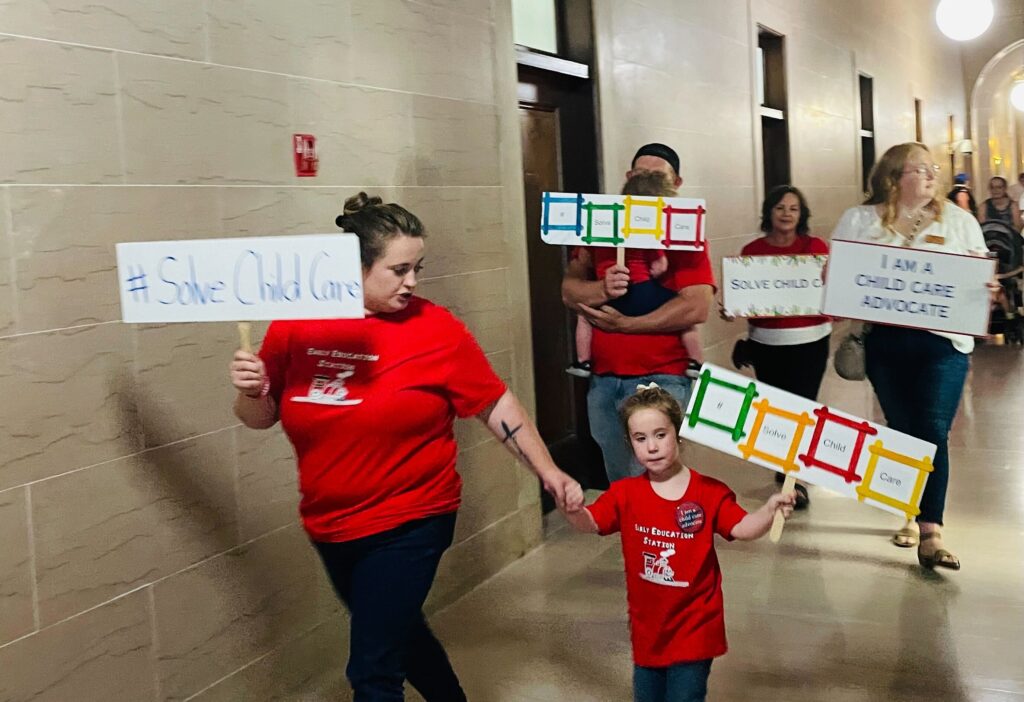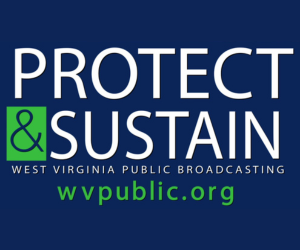Teachers, child care providers, legislators and advocates gathered outside the Capitol and called on Gov. Jim Justice and the legislature to address a child care crisis in the state.
The advocates rolled up to the event in a school bus, many with children in tow.
Currently child care subsidies in the state are facing a funding cliff and no one knows exactly when the money will run out. The state is using a finite source of federal funds to subsidize child care.
Amy Jo Hutchinson is the campaign director of Moms Rising, the group behind Sunday’s rally. She says if the money runs out, and no other funding comes through, hundreds of child care workers could lose their jobs, hundreds of parents could need to quit their jobs or reduce how much they work, and thousands of children could go without child care.
All this could have a snowball effect on some families who receive other government benefits that have a work requirement, she said.
“We hear that there may be a funding shortfall and 2,000 children may lose their child care subsidies,” Hutchinson said. “That’s 2,000 West Virginia children of working parents. They don’t tell you that there is a work and education requirement to these subsidies. They have to work to get assistance.”
Cynthia Persilly, the Secretary of The Department of Human Resources, says the funds could expire anytime but that the department will give parents receiving subsidies 60 days’ notice if they do run out.
Rising overhead costs for child care and a dropoff of pandemic-era federal funds is deepening the shortage of providers.
The federal government addressed a nationwide trend of closing child care centers by mandating a change in how those centers were subsidized.
In February, the White House mandated that child care facilities be reimbursed based on enrollment instead of attendance. This is in line with how most private child care facilities bill families, and with how nearly all public and private K-12 education is paid for.
The state was already subsidizing child care based on enrollment, it had started doing so during the onset of the pandemic. It was originally funded with Covid-era federal dollars that ran out a year ago.
Even with these extra funds via the change to enrollment available to providers, many centers are continuing to close. The cost of electricity, food and labor has gone up. Passing those increases onto the parents isn’t always an option for care providers, who receive a set subsidy or have multiple families who can barely afford the current price of their child care.
The average subsidy a family receives per child according to the Department of Human Services is $8,064. Since the subsidy covers 85 percent of the care, and the family is responsible for a 15 percent copay, the total average cost of care per year for subsidized child care is $9,487.
For families that don’t qualify for a subsidy, the price is typically much higher.
Laura Shemanga is a public school kindergarten teacher in Fayette County. She doesn’t qualify for a child care subsidy and says she spends a third of her family’s earnings on child care alone.
For her, having child care means she can afford to be a part of the state’s workforce, which has the second lowest labor participation rate in the nation.
“The Department of Health and Human Services states that child care is ‘affordable’ when it is 7 percent or less of your income,” Shemanga said. “Well, I pay more than four times what the department says is affordable. That is outrageous.”
Shemanga says she was raised in the state public school system and wants nothing more than to continue to be a part of that and teach in West Virginia, which is currently experiencing a teacher shortage.
“If you (The executive and legislative branch) cause further chaos and damage to our already very stressed child care situation,” Shemanga said, “I will have to quit my job and stay home and no longer contribute to our economy.”
She said she came to address the turmoil in the child care system.
“I’m calling out the West Virginia Legislature and Big Jim to support the families of more than 2,000 West Virginia children. Programs in Morgantown are closing. Programs in Raleigh County are closing. This is a plea from across the state to support working families so we can support our economy, our state, our future. ”
Del. Kayla Young, a Democrat from Kanawha County, said this is the main challenge facing child care in the state and is hurting the state’s workforce.
“Here in West Virginia, we’re losing child care centers left and right, and we just need to make sure folks can get to work,” Young said. “The easiest way to make sure they can get to work is to provide care for their children while they’re there.”
Justice said he plans to have a special session where these issues could be addressed, but that potential special session has yet to be announced.






















